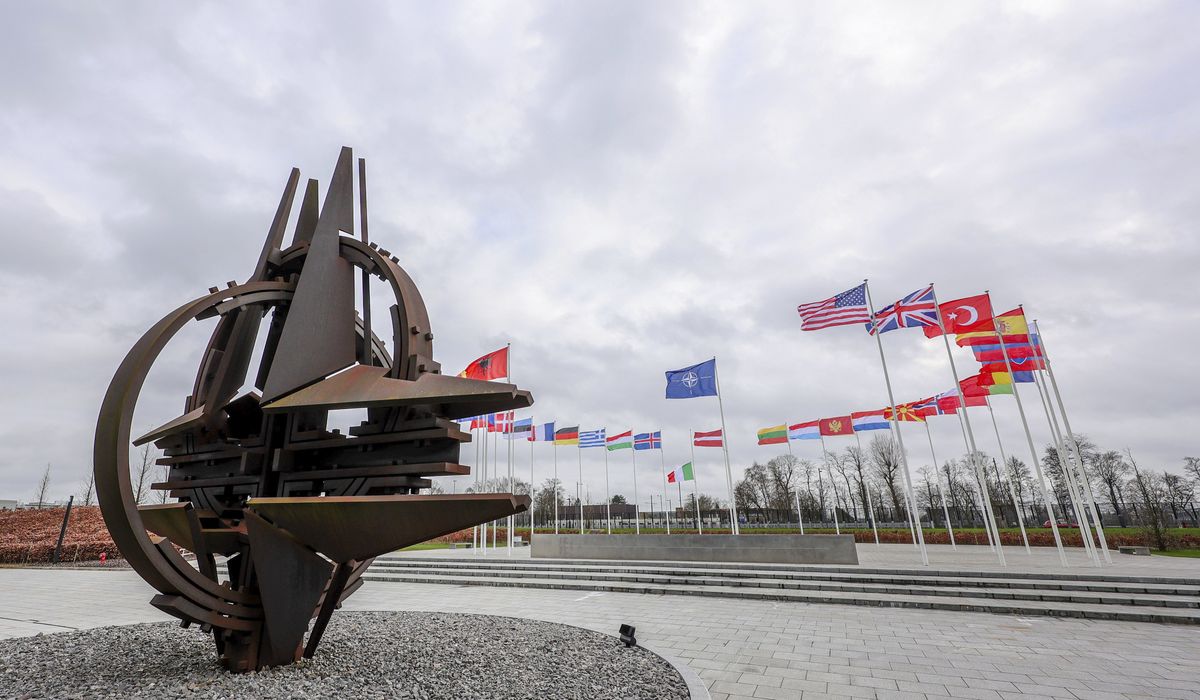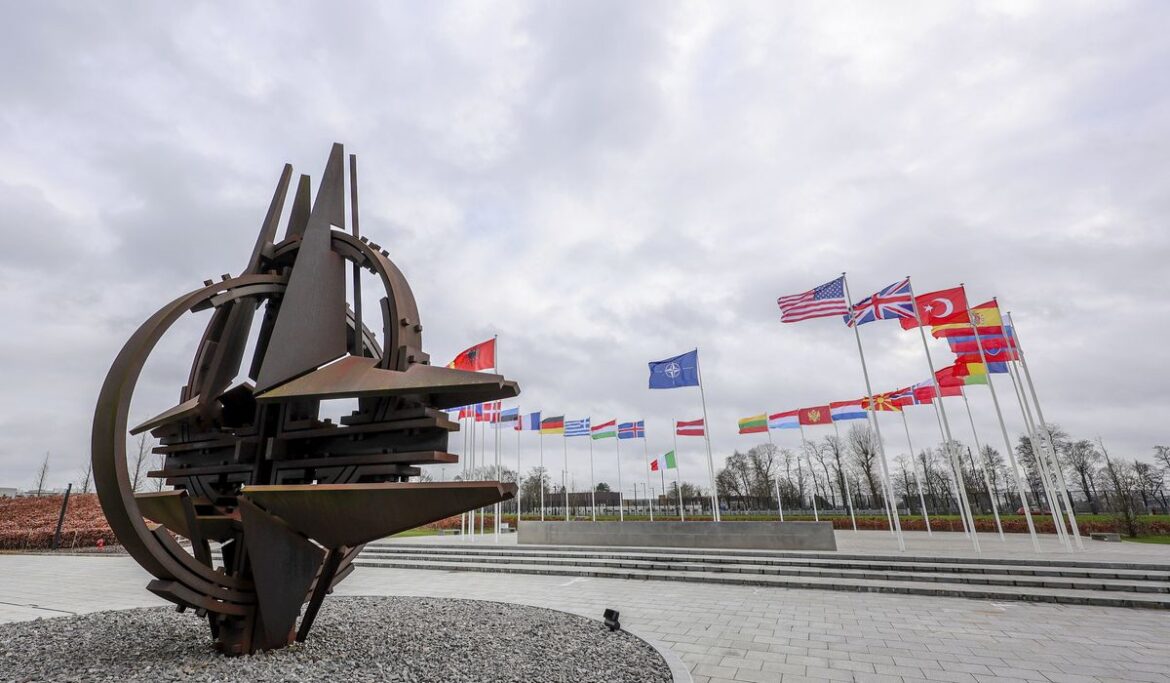
Russia‘s military advance on Ukraine is the biggest foreign policy crisis the Biden administration has faced thus far and has cast a harsh spotlight on NATO‘s relevance as a pro-democracy European security alliance capable of halting further Russian aggression in the region.
It’s a test that arrives after years of criticism that President Trump faced for the public and confrontational manner in which he called out major NATO partners for their unwillingness to meet defense spending targets and share the military burden with Washington.
Member spending has inched upward since 2019. Still, analysts say NATO has been too slow to beef up and modernize to help regional democracies deflect Russian President Vladimir Putin‘s increasing aggression — let alone counter the prospect of an authoritarian global military alliance between Russia and China. Mr. Putin, by contrast, has steadily improved once-decimated military forces, giving the Kremlin once again the power to project power beyond Russia‘s borders.
Analysts say the potential is vast for an alliance of U.S. adversaries to increase their sway over the coming decade in Europe and Asia while intimidating fledgling democracies such as Ukraine, which is not a member of NATO but is bordered by four alliance members: Romania, Hungary, Slovakia and Poland.
Although NATO has expanded to include those four and roughly a dozen other Eastern European countries over the past three decades, regional experts say the size of the alliance’s force structure has been shrinking since the end of the Cold War.
“Since the breakup of the former Soviet Union, [NATO] has cut its forces,” said longtime national security expert and former Pentagon official Anthony H. Cordesman. “This is true of the United States and each of the European countries.
“You have seen a steady decline in European and U.S. capabilities now for something on the order of nearly 20 years,” Mr. Cordesman, a senior analyst with the Center for Strategic and International Studies, told C-SPAN on Tuesday.
He made the comments as the Biden administration and NATO were scrambling to respond to the Ukraine crisis. NATO Secretary General Jens Stoltenberg called Russia‘s threat to swallow Ukraine “the most dangerous moment in European security for a generation.” Already off the table, though, is any role for U.S. and alliance soldiers directly confronting Russian forces inside Ukraine, something President Biden has consistently rejected.
Mr. Stoltenberg said NATO stands “in solidarity with the Ukrainian people” and will continue to provide equipment to Ukraine‘s military. He stressed that NATO nations bordering Ukraine can rest assured that the alliance will do whatever it takes to shield them from Russian aggression.
Ukraine is Mr. Putin‘s immediate target, but the Russian leader has the larger challenge of NATO in his sights. Two of his top demands are that NATO promise never to take in Ukraine as a member and that the Western alliance roll back its troops and weapons from a broad swath of Eastern Europe near Russia‘s western borders.
Delivering on promises
Questions are swirling around NATO‘s capability to deliver on those promises. “We have over 100 jets at high alert, and there are more than 120 allied ships at sea, from the high north to the Mediterranean,” Mr. Stoltenberg said Tuesday. He said members have deployed thousands of troops to the alliance’s eastern flank and placed more on standby.
In early February, Mr. Biden ordered 2,000 U.S.-based troops, including elements of the 82nd Airborne Division, to Poland and Germany and shifted 1,000 other American forces from Germany to Romania. The Pentagon expanded the moves Tuesday. Defense Department officials said 800 troops from a U.S. Army battalion in Italy, likely to be drawn from the 173rd Airborne Brigade, are also being shifted to the Baltics.
Officials added that a battalion of 20 AH-64 helicopters and up to eight U.S. F-35 Strike Fighters in Germany are being shifted to Eastern Europe and an aviation task force consisting of roughly 12 AH-64 helicopters are moving from Greece to Poland.
The American personnel and equipment movements are the most dramatic Washington has engaged in Europe in recent memory. They also far outstrip any troop and equipment commitments from other NATO members in response to Russia‘s moves in the region.
Four Danish F-16 fighter jets arrived in Lithuania in late January to bolster NATO‘s air policing mission there, according to Voice of America. NATO countries have deployed roughly 4,500 troops to Estonia, Latvia, Lithuania and Poland since Russia‘s forceful annexation of Ukraine‘s Crimean Peninsula in 2014.
France recently announced plans to send several hundred troops to Romania. Germany, the Netherlands and Spain have said only that they are considering sending troops to NATO‘s eastern flank.
Other major members of the alliance have focused on arming and supporting the Ukrainians. Britain reportedly is sending a team of 30 elite training forces and supplying some 2,000 anti-tank weapons.
Turkey has said it will sell drones to Ukraine, and both countries are moving ahead with plans to co-manufacture sophisticated drones, according to Defense News.
Still, NATO has repeatedly had to react to Mr. Putin‘s moves against Ukraine, said retired Gen. Philip M. Breedlove, NATO‘s supreme allied commander from 2013 to 2016.
“Right now, we are in passive deterrence, and Mr. Putin is in active measures,” Gen. Breedlove said in an interview Tuesday with Air Force Magazine. “That’s why I think we see, now, Russians moving into Ukraine.”
Piecemeal
Many regard the NATO response as too piecemeal to deliver the level of deterrence necessary to stare down a Russian military wholly focused on its smaller neighbor. Analysts say NATO‘s limitations explain why the Biden administration is focused on using sanctions rather than a show of military force to try to roll back Russia‘s aggressive moves.
Retired four-star Army Gen. Jack Keane said NATO would be dramatically outmatched if Russia threatens other Eastern European nations with anything like the 150,000-plus troops it has massed on Ukraine‘s border.
“If [Putin] massed that on any one of the NATO countries that are on his border — Poland, the Baltics — there’s no match for that there,” Mr. Keane said in a Fox News appearance Monday. “That would take a massive deployment to provide that kind of a match for Putin‘s capabilities.
Mr. Keane said the U.S. should have pushed more aggressively for the NATO Response Forces, consisting of roughly 40,000 multinational troops as well as air and naval assets, to deploy to the region. “It should be done,” he said. “I’m not suggesting that Putin‘s going to move on Poland, but we’ve got to make sure that he understands that we’ve got the determination and resolve to do something about it if he‘s thinking about it.”
Mustering such resolve may prove more difficult than officials want to acknowledge. Mr. Trump wasn’t the first U.S. president to gripe openly about NATO allies’ failure to spend enough toward upholding the alliance.
Presidents George W. Bush and Barack Obama expressed frustration that the U.S. shoulders most of the costs. Both presidents pushed for France, Italy, Germany and other members to meet their defense spending commitments. The efforts, along with Mr. Trump‘s pressure, yielded mixed results.
An analysis published last week by the Center for Strategic and International Studies said the alliance should have been put on high alert after Russia‘s 2014 annexation of Crimea. It said the U.S. specifically “failed to lead effectively at the presidential level.”
“It failed to effectively rebuild its forward deployed forces and power projection capabilities,” Mr. Cordesman and Grace Hwang, a research assistant at the think tank, wrote in the assessment. The analysis was particularly critical of Mr. Trump‘s aggressive approach on the issue of NATO member spending.
Critics said Mr. Trump went too far by threatening to pull the U.S. out of the alliance if other members didn’t increase their spending.
“The Trump administration effectively turned U.S. policy toward NATO into a mathematically absurd form of burden-sharing bullying,” Mr. Cordesman and Ms. Hwang wrote. “It pushed America’s European allies to spend more without addressing their many differences, the very different key deficiencies in most member countries’ forces, and their very different shortfalls in modernization and interoperability.”
• Mike Glenn contributed to this report.





